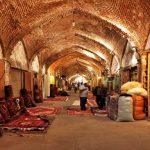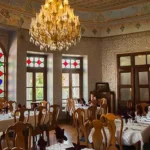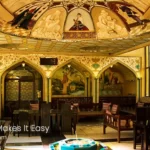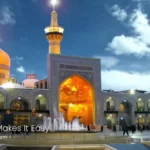Persian carpet weaving historical tour
Introduction
Persian carpet weaving has been an inseparable part of Iranian culture. In fact, most people around the world have at least heard of the Persian carpet-weaving industry and its magnificent products. If you are interested in Iran and Iranian culture, you might want to familiarize yourself directly with this valuable and prestigious aspect of Iranian art. What would help you do such a thing better than visiting a place where various Persian carpets, from different historical periods, are displayed all at once?! That place certainly is the Carpet Museum of Iran. In this article, we first explain the Iranian carpet through a socio-historical lens and then introduce the Carpet Museum of Iran and its valuable items for those interested in a carpet-weaving historical tour while they are in Iran.
Kental Iran Travel is an Iranian tour guide agency that offers various touring packages, including a Persian carpet historical tour, at affordable costs and with high-quality touring services. Visit Kental Iran Travel’s website to see their touring options.
Iranian Carpet weaving
Throughout history, Persian carpets we made by both nomadic communities, which constituted about one-third of Iran’s population by the mid-19th century, and sedentary peoples – in rural areas as well as in workshops and private businesses in urban communities. Therefore, Persian carpets are, in a sense, portfolios of the cultural identities of various Iranian peoples. Especially, the Safavid era is the age of flourishment for the Persian carpet industry – multiple carpet weaving workshops across Isfahan, then the capital of Iran, and other cities made tens of thousands of prestigious carpets each year. Back then, the products of the Persian carpet-weaving industry were primarily for exportation to Europe by Dutch and British merchants of great mercantile companies of the early modern period.
Persian carpets are woven in many different cities in Iran today. Persian carpets are famously known for their unique weaving techniques and the high quality of materials used in them. For example, the use of fine wool, lively and intricate colors, and the unique and stylistic patterns in which they are woven. Especially, Persian carpets woven by rural and nomadic weavers are most commonly viewed as the authentic Persian carpet, although they are coarser and are not pre-planned. Gabbeh carpets which are the most prestigious Persian rugs available in the market belong to this group of Persian carpets.
Carpet Museum of Iran
The Carpet Museum of Iran is located in Laleh Park at the center of Iran’s capital, Tehran. The construction of the museum was completed in 1978 by Farah Pahlavi, the wife of Iran’s last shah. The primary goal of such a project was for education and research in Iranian arts. However, creating a collection of Iranian carpets in the form of a public museum was another goal of the big project.
The Carpet Museum of Iran is constructed in an area of around twelve hundred square meters and has unique and modern architecture designed by one of the most well-known Iranian engineers of that time. In particular, the exterior of the museum depicts Iranian traditional carpet-weaving machines.
The building of the Carpet Museum of Iran has an area of 3400 square meters and consists of different sections, including a permanent hall, exhibition hall, restoration workshop, and library, among others. Below, we will try to describe what you will see when you enter the Carpet Museum of Iran, although seeing it yourself is completely different and will leave you mesmerized by the glamour you will find in the museum!
NOTE: Kental Iran Travel is a Tehran-based travel agency that offers various touring packages, including a Persian carpet historical tour, at affordable costs and with high-quality touring services. Kental Iran Travel also offers the best Iran tour guides to visitors to Iran. Visit Kental Iran Travel’s website to see their touring options.
Ground floor
On the ground floor, which is the permanent hall of the Carpet Museum of Tehran, you will be presented with 150 stunningly beautiful carpets, the oldest of which dates back to the 16th century. 135 of these carpets were woven in Isfahan, Tabriz, Kashan, Kerman, Khorasan, and Kurdistan. The unique coloring and design of these carpets will take you back and forth in Iranian cultural history.
Figure 3 Ground floor – Carpet Museum of Iran
First floor
The first floor includes various sections each of which presents native and foreign tourists with unique aspects of Persian carpet weaving culture. Various temporary, seasonal, and international exhibitions have been held on the first floor of the Carpet Museum of Iran. Below, we will describe what sections you will enter on the first floor of the museum.
Figure 4 First floor – Carpet Museum of Iran
Exhibition hall
In this hall, numerous films and slides are displayed to the audiences to familiarize them with the carpet-weaving industry of Iran. Especially, you will be presented with a lot of useful information about the methods of the internationally-known carpet weaving industry in Iran through a historical lens.
Figure 5 Exhibition hall – Carpet Museum of Iran
Library
In the professional library of the Carpet Museum of Iran, you will find more than 3500 volumes of literature about the Persian carpet-weaving industry in Persian, Arabic, French, English, and German. In addition, there are the latest volumes of research journals about the Persian carpet industry.
Figure 6 Library – Carpet Museum of Iran
Carpet restoration workshop
In this workshop, as the name of this section suggests, carpet specialists restore old and torn carpets. Specialists here apply various methods of restoration of carpets to preserve this valuable collection of magnificence for the coming generations.
Figure 7 Restoration workshop – Carpet Museum of Iran
Carpet weaving classes
After seeing all this beauty in the Carpet Museum of Iran, you may want to tie the knots and weave a carpet yourself! The museum offers carpet weaving classes at two elementary and advanced levels. The teachers are chosen from among the best specialists of carpet weaving in Tehran. At the end of the courses, you will be given a license that you can use to create your own business in carpet weaving in your own country.
Conclusion
In this article, we first offered a brief history of the Iranian carpet-weaving industry. Then we introduced the most important carpet museum in the nation, the Carpet Museum of Iran, which you can visit during your travel time in Iran.
Kental Iran Travel is one of the most experienced Iran tour guide agencies that offers various touring packages, including a Persian carpet historical tour, at affordable costs and with high-quality touring services. Visit Kental Iran Travel’s website to see their touring options. Also, if you are interested in carpet weaving classes at the Carpet Museum of Iran, you can contact Kental Iran Travel.
















